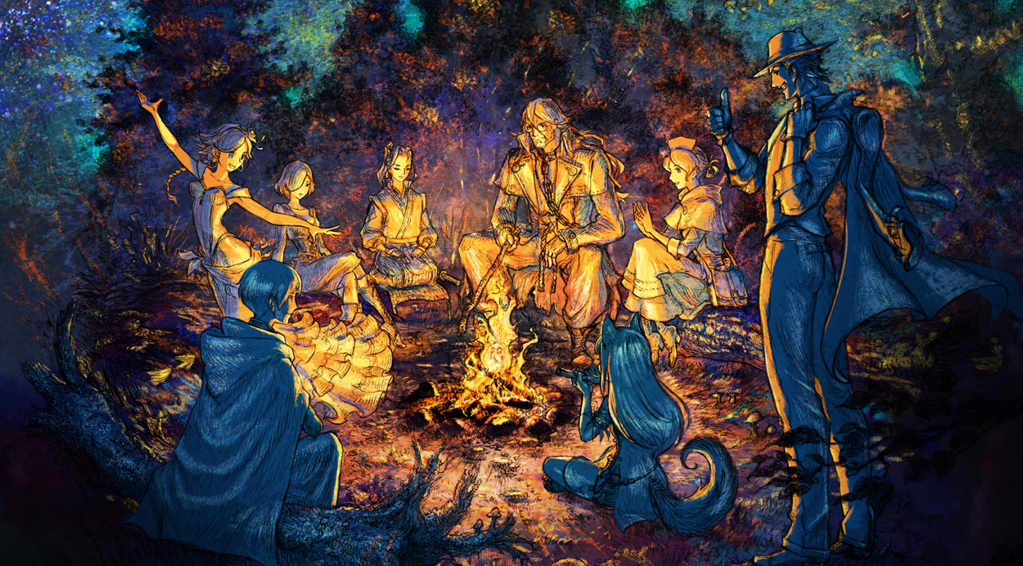Square Enix has long had a love affair with the multi-strand story; the recently re-released Saga Frontier, the remake of Live A Live, and the first of the series and now Octopath Traveler II. Not so much branching narrative as multiple concurrent ones, not so much two leads as literally eight. It’s an ambitious storytelling structure for an RPG, generally a genre that goes for epic quests that take a long time to play, and rely on high-content releases.
Octopath and its new sequel were a hark back to this heyday idea that never really took off outside the SaGa games, and let’s be fair, they’re niche at best. Except Octopath Traveler isn’t – through deft character writing and that jaw-dropping 2DHD style that so captivates fans of keeping retro pixelart alive, it’s managed to completely outshine SaGa and satisfy the die-hards and the newcomers alike.
The first game wasn’t without its issues – high grinding and difficulty, and criticisms that its eight storylines didn’t really have much to do with each other. Octopath Traveler II seeks to build on its predecessor with even more beautiful, better-balanced battling, and another eightfold story, that this time seeks to enmesh each of the threads together into a whole. Does it manage it?
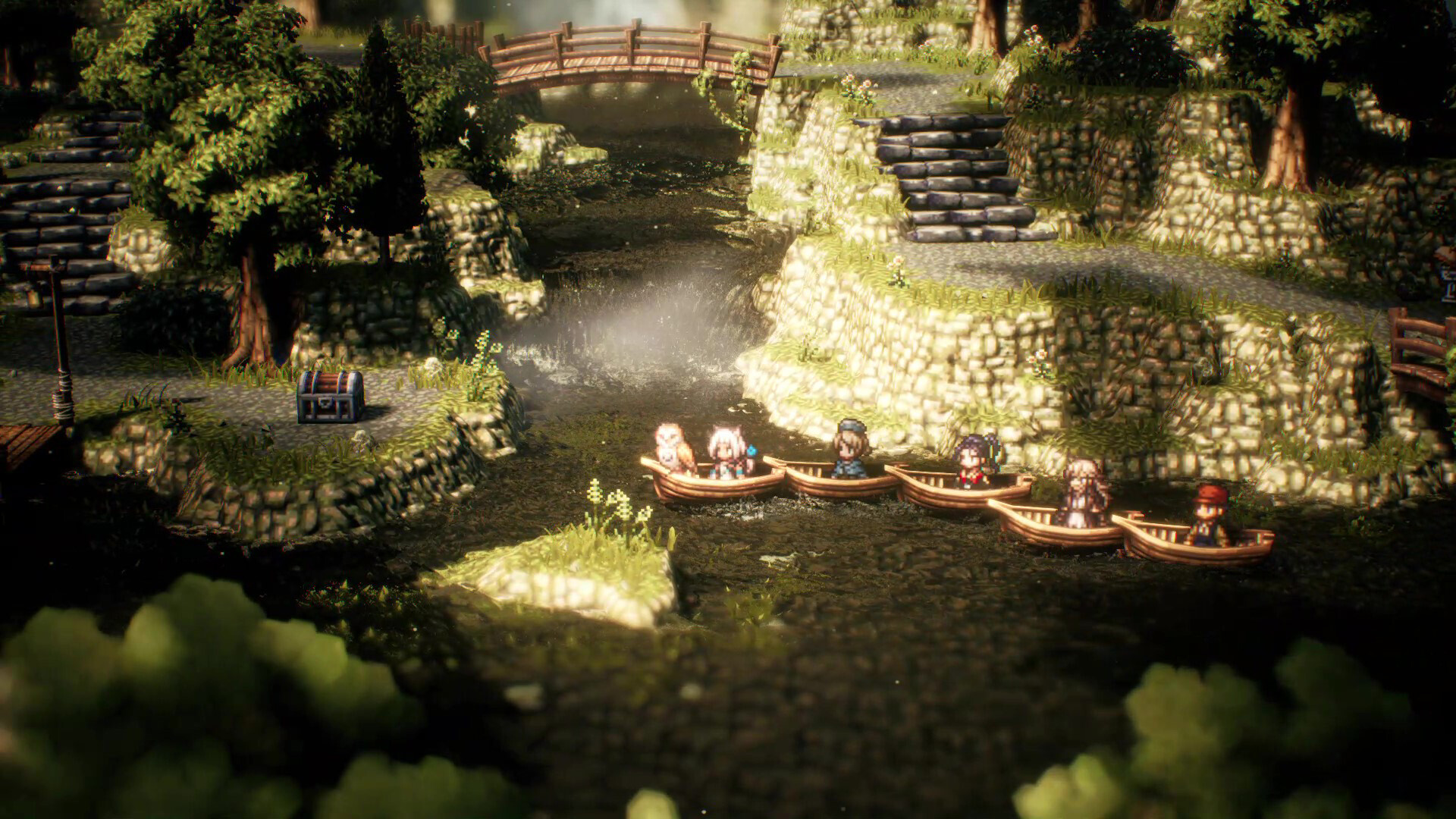
Perhaps the most important part of Octopath as a series is the investment of the player in its eight short stories format, instead of an epic single narrative. Because of this vignette structure, Octopath Traveler II can feel incredibly character-driven and also fragmented. You’re not out to save the world, you’re out to clear your name, avenge yourself on your enemies, or become a famous dancer. In some ways, it’s like taking on eight subquests from a far bigger game, and making that the sole focus. Of course, if you are going to stake your game on sub-quests, you better upgrade them to the best sub-quests you can think of, otherwise it’s time to go home right off the bat.
Thankfully, Octopath Traveler II’s writing is some of the best in the JRPG genre. Eight potent, evocative, and involving tales are established, with clear and often emotively strong destinations set up to continue each story. I’ll start with the strongest.
We have Throné (Throw-nay not Throne), an orphan assassin since childhood, whose abusive relationship with her adoptive Fagin stand-ins is brutal and unjust. Her story starts with the manipulative infighting in the Blacksnakes and blooms into a tale of taking control of your adult life and getting revenge.
We have Temenos, a doubting Thomas-type Inquisitor Priest, far better at solving murders than he is at delivering scripture. I love a doubting priest character and his nonchalant disrespect for the church is a joy to hear throughout the game. Temenos’s story is one of investigation – five minutes too late to stop the murder of the church’s pontiff, he sets out to find the culprit, even if it brings him into direct conflict with the religious establishment.
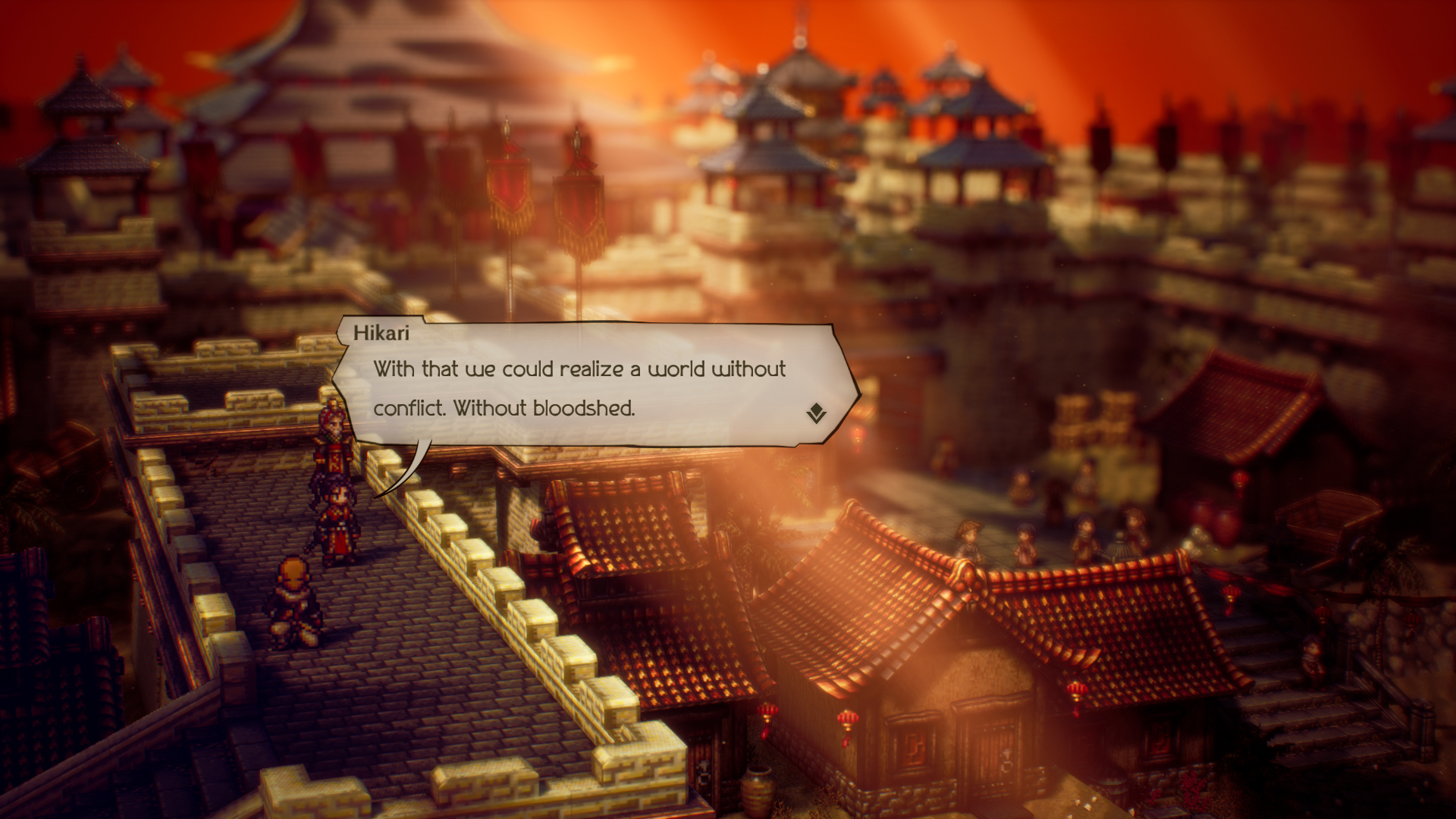
Perhaps the most cinematic tale is Hikari’s. The younger prince of the Ku people (think ancient Chinese warriors), he is named as heir to the throne in place of his elder brother, Mugen. Mugen takes this very badly, commits patricide, takes the throne, and Hikari only just escapes with his life. Now he must find his scattered allies and take back his throne.
Osvald is a wrongly accused scholar who must escape from a high-security frozen island prison and then seek to clear his name. Ochette the beastling girl must save her village from the Night of the Scarlet Moon by seeking out three legendary beasts.
Slightly less inspiring are the more familiar stories. Castti the apothecary is an amnesiac but remembers her skills in healing. Her story, like anyone with amnesia, is to piece together her previous life, and how she came to lose her memory. In perhaps the most naïve story, Agnea the Dancer leaves home to make it as a star, completely blind to all pitfalls. And Partitio the merchant leaves his frontier silver mine town to ‘rid the world of all poverty’ – good luck mate.
One criticism I had for the stories, or at least the characters, is that despite their depth and originality, I felt I’d seen it all once before…in the first game. Hear me out, Temenos is the new Ophilia, the priest/priestess character; Partitio is the new Tressa, the merchant; Osvald is the new Cyrus, the dark scholar; Hikari is the new Olberic, the Knight/warrior; Castti is the new Alfyn, the healer/apothecary; Throne is the new Therion, the thief; Agnea is the new primrose, the dancer character; and Ochette is the new H’aanit, the beastgirl character. A few gender changes and some switcheroos on who’s searching for things and who’s after revenge, and it’s largely the same. If you played the first game, there will be a sense of deja vu.
But stories in the original Octopath Traveler were great, well-written and in a few cases even memorable. Even so, Octopath Traveler II has upped the ante considerably from its predecessor. The stories of almost all eight characters are tightly plotted, evocative and emotional, full of injustices to rail against and clear objectives to follow. They’re rife with nuanced character writing and memorable situations that don’t generally appear in JRPGs – clearing your name, or the aspirations of a dancer – these are the types of roles that often get overlooked in a broad strokes epic. Towards the end, it even manages deft, often unexpected, and fulfilling conclusions to these stories that wrest emotional connection and catharsis from the player.
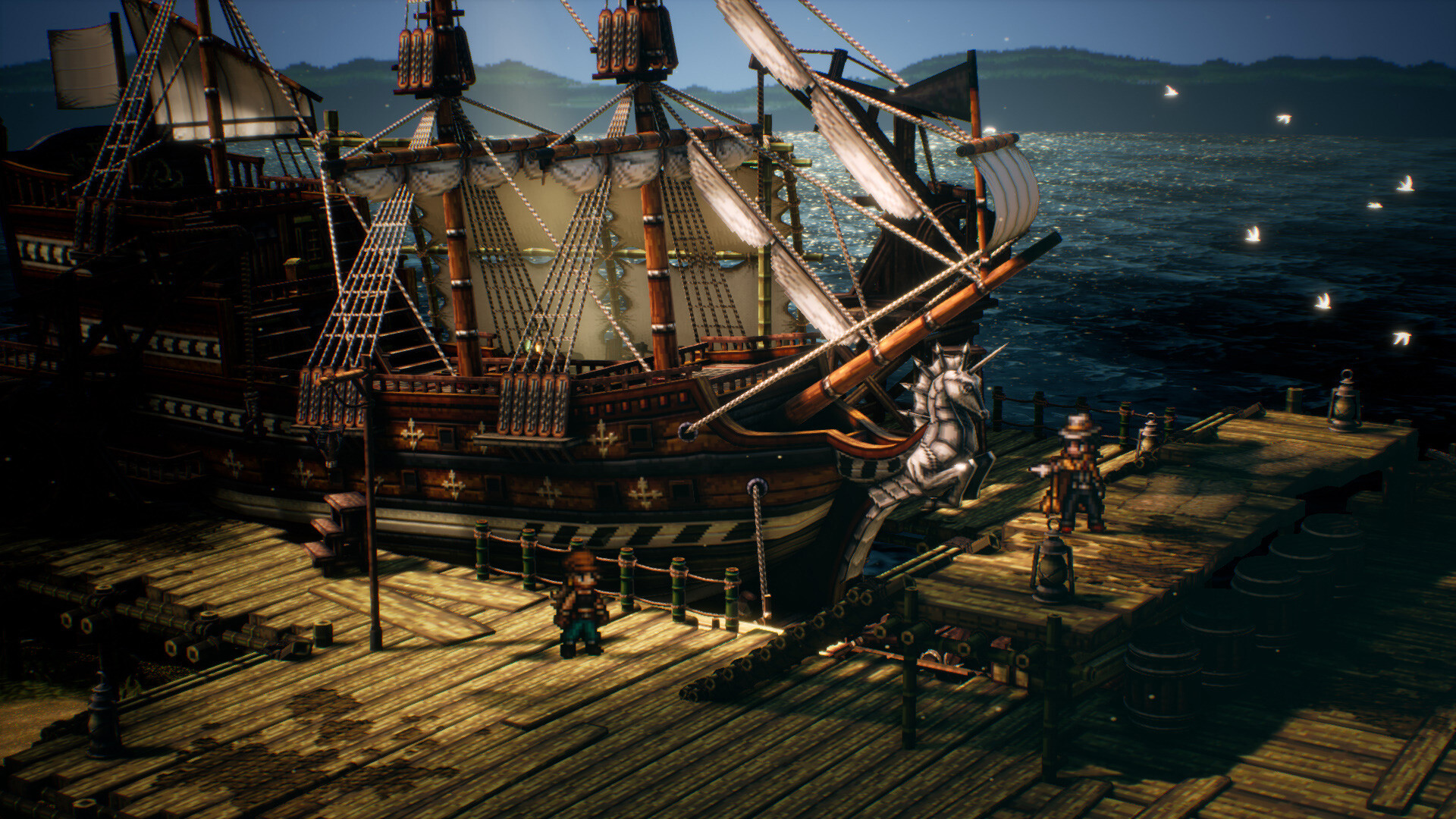
The way Octopath Traveler II improves on its predecessor’s story is to have the different stories interconnect relatively early on. The player will see the usual chapter dotted about the world map to explore, but then also duet chapters where two characters will take on some story together. These begin quite innocuous, but soon become interesting diversions, and some taking an even more centre stage than the character’s own respective stories. It’s a great achievement that builds until all the stories have connections and there are reasons for them all to be heading for that final confrontation. In addition, this installment features a ‘Tales’-like skit mechanic, in the form of party chat – once you’ve got the bulk of the characters they will talk to each other about what’s going on in each other’s chapters.
Octopath Traveler II’s world has also had an upgrade – to a further stage in civilisation. Industry and invention replace fantasy and village life, trains and cities replace horses and townships. This new industrial age world of Solistia allows for tales that deal with poverty and ambition, with banks and money and merchants, with unstoppable progress and change, and the people and cultures it leaves behind and those it elevates. The Industrial age is a fantastic place to set your story currently – it’s in the zeitgeist in fantasy writing as authors move beyond medieval sword and sorcery into gunpowder, frontiers and money. This change above most of the others gives Octopath Traveler II its own identity, clear and distinct from the first game.
As in the first title, each character has field actions they can perform with NPCs. This might be challenging villagers to duels, bribing or ambushing them to move aside from a door you want to access, or stealing precious items from them. Most are pretty uninspiring, and rarely needed outside of prompts in the story chapters. All except for Throné’s steal command which I used regularly to wring entire towns of their valuables and upgrade my party’s gear. Overall, this mechanic feels the same as the first game and relatively under-implemented.
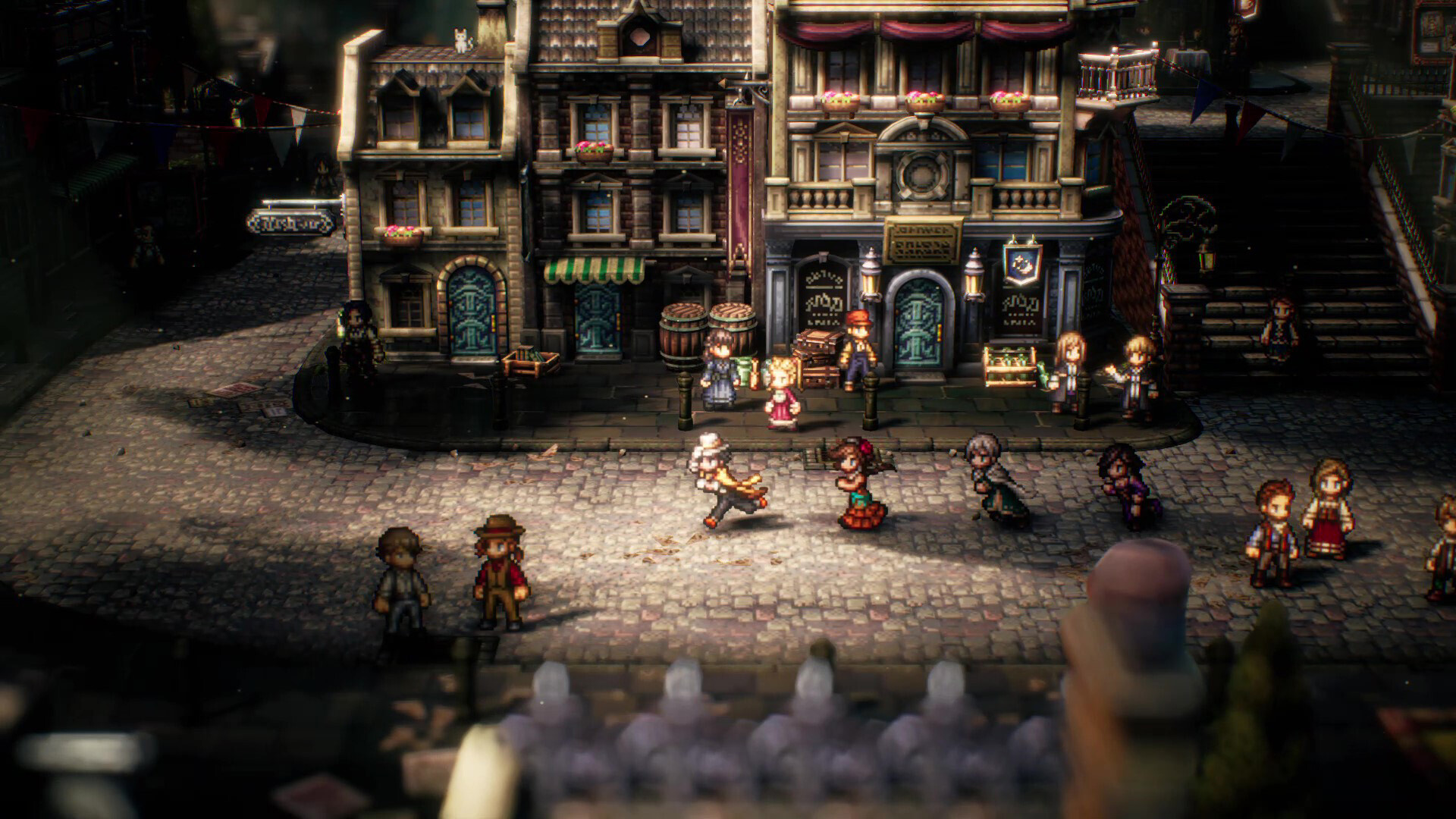
Battles are probably the part of the package that’s had the smallest facelift. Things are still very grind-heavy, and battles, especially bosses can be hard if under-levelled. The Break and Boost system is back largely the same as its predecessor – use the correct weaknesses of your enemies and attack a certain number of times to ‘break’ them, leaving them in a vulnerable low defence state for a turn or so, then unleash your strongest moves during this time.
Every turn you don’t boost, you accumulate boost points (up to 5 total) that allow you to act multiple times in a turn, or upgrade moves to high-level versions for higher damage. For best results, hold back boost points, Break an enemy and then unleash your boost points to inflict the absolute heaviest damage possible over the turn when the boss can’t retaliate.
It’s a great dynamic system that allows for lots of options and forethought in your turn-based battles. You can plan how to take down the huge intricate bosses, and make moves that are five moves ahead, like a master strategist. It’s clear this style has become a big deal in Square Enix over the last five years, as it appears in the Bravely Default games too, although with a very important difference – in Octopath you can act even in the turn you accumulate boost, in Bravely Default you must defend, and sacrifice your turn to unleash multiple turns at once. I vastly prefer the Octopath Traveler II system, as you can still act. It also resets to ZERO in Octopath Traveler, as opposed to the potential minus turns you can inflict on yourself in Bravely’s system.
Outside of break and boost, battles are dynamic things with camera movement, particle effects, and the same grand lighting as in the main field areas. You have basic attacks, magic or job-based skills and damaging or healing items. You can also pick up secondary jobs in an opposite weakness to augment your prowess in battle. Battles somehow look modern and retro, and play out in a fast and furious fashion that feels at odds with their turn-based nature. On the downside, there is still a heavy grind necessary, and bosses can provide high-difficulty blocks to progression unless you spend time levelling your characters, especially the four that don’t spend equal time in your main party.
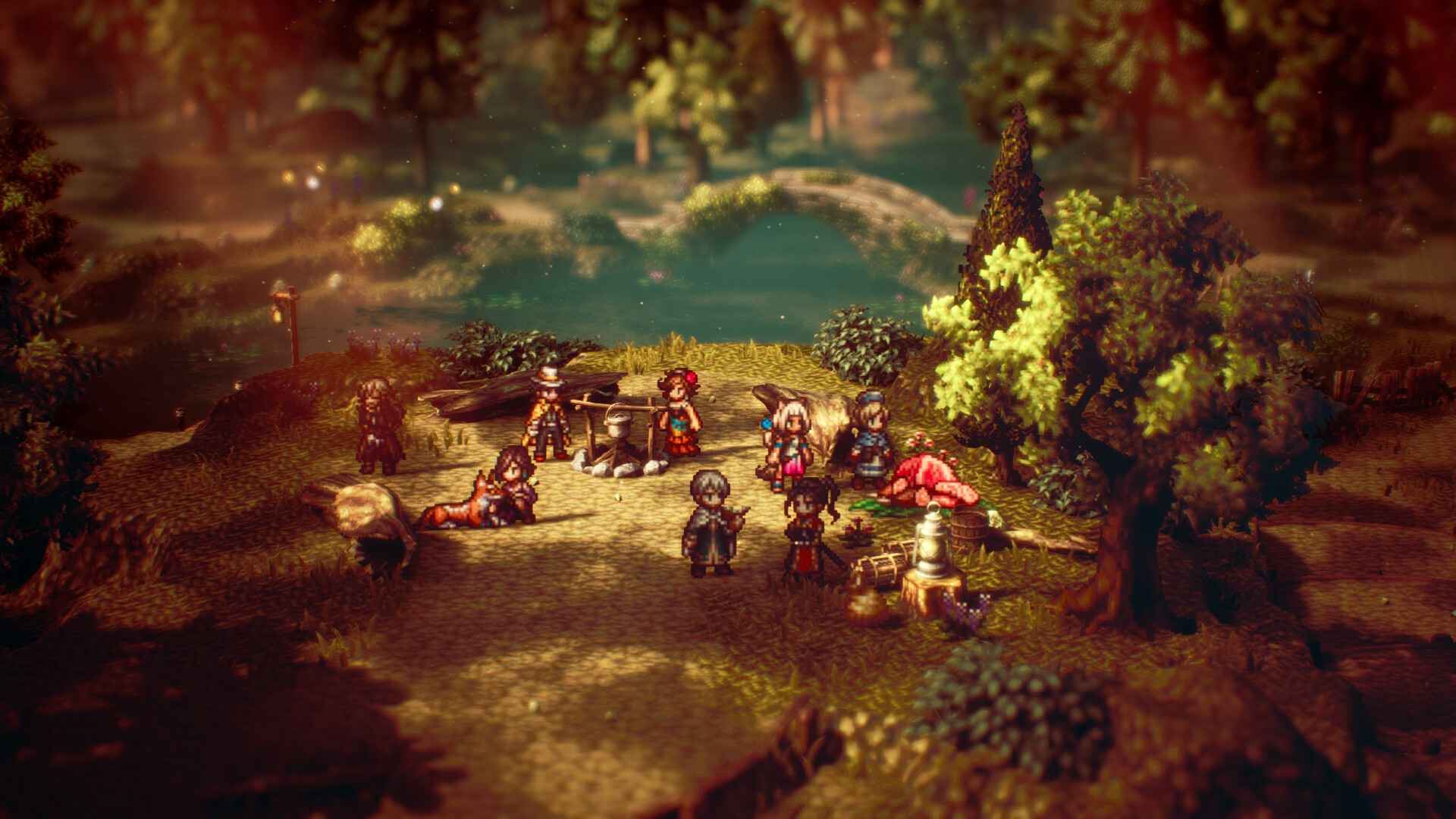
The first Octopath Traveler is renowned for some of the best and most dynamic compositions and modern music tech in all of JRPGs. The sequel manages to outdo it here too. Battle music is memorable and complex and interesting to listen to on repeat, there are day and night versions of each town’s theme along with the swapped graphics, and every dungeon and field area really feels like it has its own identity.
On the sound side, each of the main character’s entire narrative arc is fully voiced, from the leads, to the bit parts and crowds. And voiced really damn well. This is the top echelon of anime and video game voice actors, and they never put a foot wrong. Only town dialogue and side quest-type areas are not voiced, and it means that Octopath Traveler II is very accessible, and involving form a sound perspective when often RPGs that look like this are almost silent.
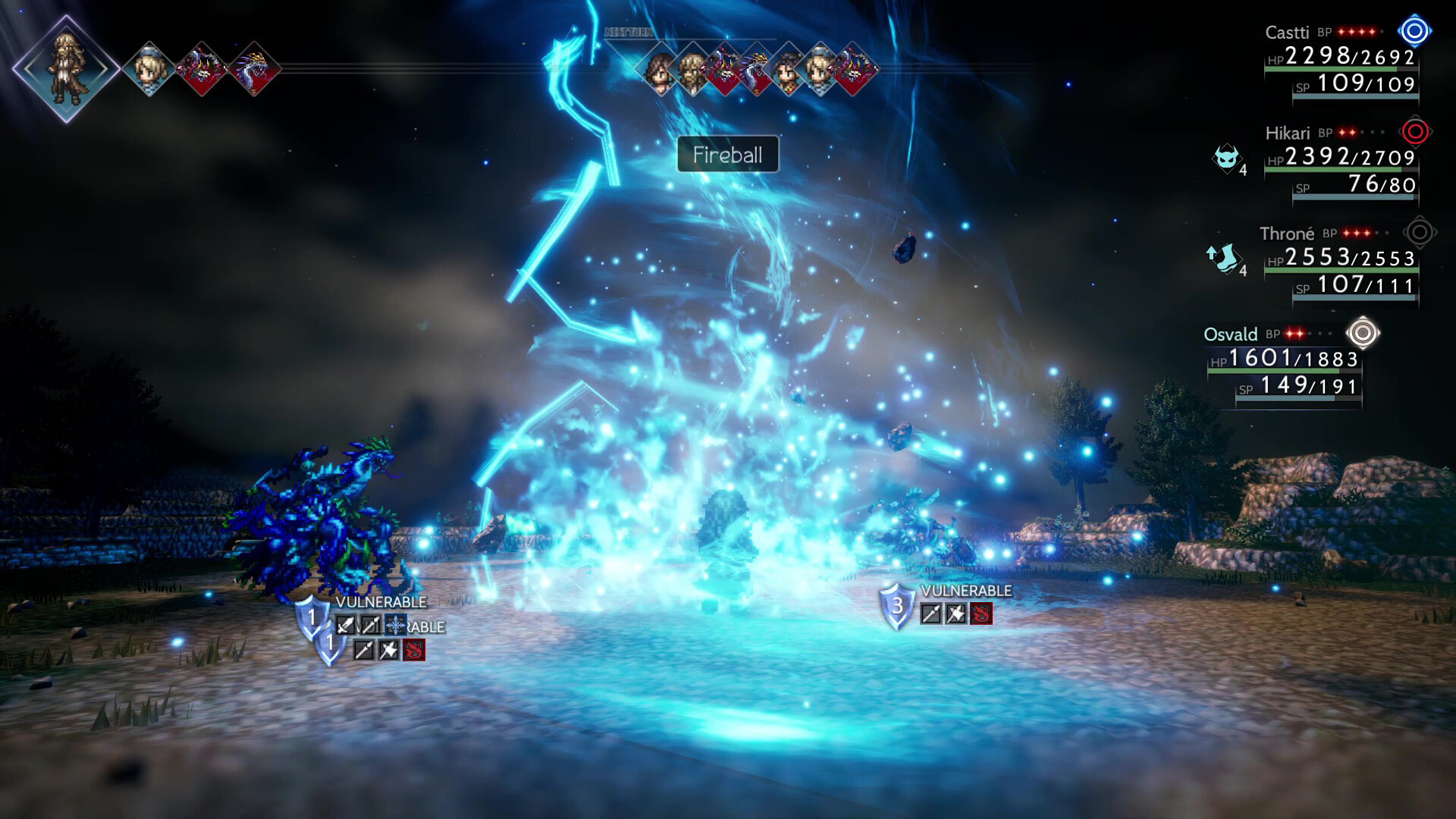
For a game trying to incorporate speed, and more moment-to-moment compelling gameplay into its runtime, it’s strange to see such a hardline retro approach to grinding levels. Bravely Default II two years ago, introduced 2x, 3x, and even 4x speed to its battles to combat what it clearly knew was a very grind-heavy demand on player’s time. I always thought this a strange sticking plaster on something you could have fundamentally changed. Octopath Traveler II has no incongruous contradictory system to aid the grind, but battles are at least generally fleet and bracing. I think it’s a strange oversight in a game where so much is being upgraded and enhanced, modernised and rethought, to fall back on such an archaic system.
You know what you are getting in for with a JRPG it seems. With the amount of reimagination and invention on show, it’s a shame it did not extend to this system, though at least its not as contradictory as BDII’s was. Perhaps in a possible Octopath Traveler III grinding will be something reimagined for the better.
The first meetings of the characters are a little disappointing. Often the ‘meet-cute’ of a JRPG journey is the interesting clash of your party with new parts of the game world’s culture, and enmeshing this new character and their interactions with the team is what then cements them firmly in your heart. Octopath Traveler II gives these wonderful first chapters, but the actual meeting of characters is almost always a rather sad, perfunctory, mutual agreement to travel together. Later in the character’s storylines others get involved and things start to mesh better and feel more like one story.
Of course, you can pick any path you wish to start with, but you are going to want four characters pretty quickly so that you can fight effectively. There’s no good reason not to work your way round four characters you’re interested in, or the four closest together. However at that point, I would suggest you don’t immediately go for the other four. You’ll get to them and probably quite soon, but if your level allows, I’d get stuck back into one of your four character’s narratives. The reason being that by the time you’ve done eight first chapters, much of the impact of the first two or three has been lost and largely forgotten in ten hours of play. They’ll all keep. That said, make sure you’ve got them all before you start on any chapter threes.
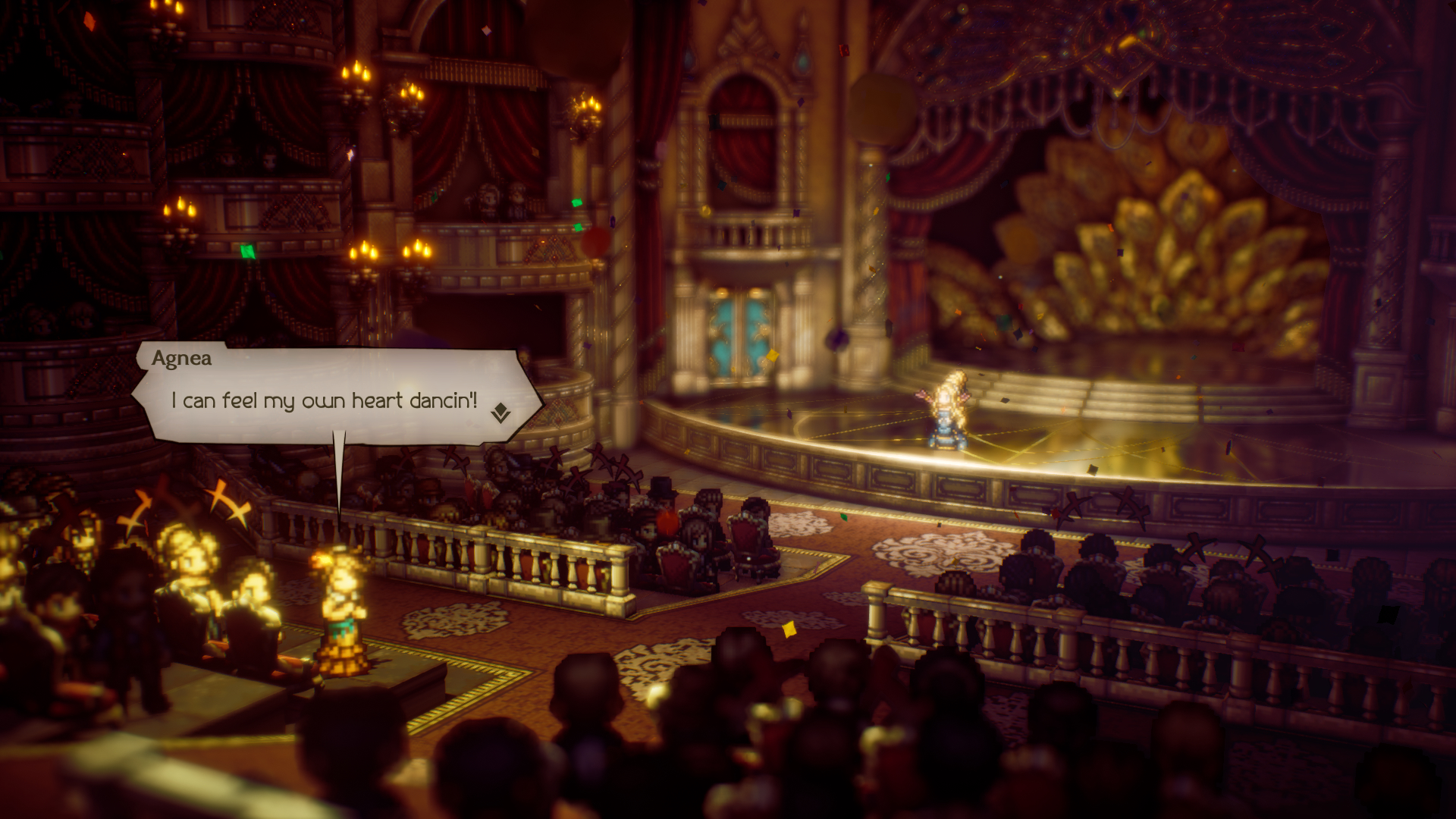
So do Square Enix’s multi-strand stories work, and in particular does Octopath Traveler II deliver? Well, on the former question, I think there’s plenty of space in the JRPG market for the smaller less epic quest-style stories. Multi-strand offerings lend themselves to this style because let’s face it, eight epic fantasies at once might get a little hard to follow. Octopath Traveler II is, without doubt, the best of these that Square Enix has thus far managed to write or market.
It’s approachable where the SaGa games were and are obtuse; it’s fun and rewarding; its stories are still a little disparate to start with, but come together to form a spiralling mesh of all the characters that is possibly the best of both worlds. It’s all fantastically retro and beautifully modern at once. If the recent spate of high-budget modern RPGs have left you cold and yearning for that nostalgia hit of the genre’s heyday, Octopath Traveler II will barely ever put a foot wrong.
It’s also the most beautiful example of pixelart on the market today. That HD2D style they’ve coined is superb and with each new release it gets more lush and vibrant and pretty. It makes Solistia a world I just want to get lost in, and the deep accomplished writing on show means I can. Nothing pulls you out of the experience; no voice, no plot, and no strangeness mars the journey.
A masterclass in narrative convergence, the eight-fold seemingly disparate paths of Octopath Traveler II come together to form a tightly plotted and engaging whole. Though its gameplay is not ground-breaking, its battles are fun and rewarding and manage to cut out much of the grind of its predecessor, making it an essential JRPG experience.

Octopath Traveler II is out now on Nintendo Switch (review platform), PlayStation 4 and 5, and PC via Steam.
Developers: Acquire, Square Enix
Publishers: Square Enix
Disclaimer: In order to complete this review, we purchased a physical copy of the game. For our full review policy, please go here.
If you enjoyed this article or any more of our content, please consider our Patreon.
Make sure to follow Finger Guns on our social channels. Twitter, Facebook, Twitch, Spotify or Apple Podcasts – to keep up to date on our news, reviews and features.
